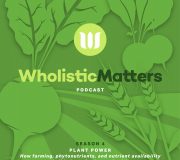About this Episode
In the fourth episode of Plant Power, the fourth season of the WholisticMatters Podcast Series, our topic is phytonutrients and the valuable relationship between food and color. Our guest this episode is nutrition scientist Weston Bussler, PhD. Listen all the way to end for clinical insights from practitioner Dave Hogsed, DOM, AP.
What Are Phytonutrients?
Phytonutrients are plant-based compounds associated with beneficial health effects, often antioxidant and anti-inflammatory. As secondary metabolites produced by plants, phytonutrients act as signaling molecules that elicit important functions for the plant.
Research shows that phytonutrients can benefit human health as part of the diet, often acting as direct antioxidants and interacting with inflammatory pathways, like NRF-2. The diversity of phytonutrients in the diet is directly related to the health-promoting, disease-preventing aspects of colorful, plant-based diets.
Quantifying Phytonutrients
Measuring gallic acid equivalents (GAEs) is one way to understand that all colors are valuable when it comes to plants, specifically by quantifying total phenolics, a group of phytonutrients that include phenolic acids, flavonoids, and condensed tannins. Phenolics are universally present in plant-derived foods and have been long-linked to the health properties of a plant-based diet.
Scientists can quantify “total phenolics” between different plants by measuring GAEs, which can be used to compare the amounts of phytonutrients and the total phenolic compound content of different foods.













